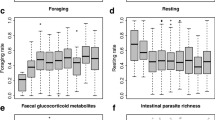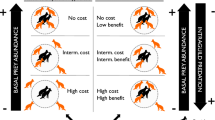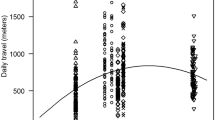Abstract
Data from three populations of gelada baboons are used to generate a model of the species' socio-ecology that relates time budget requirements to group size, day journey length, and relevant environmental parameters. The model is used to examine the range of environmental conditions under which gelada could survive. This analysis indicates that a grazing primate like the gelada would run out of available time for foraging at just above and just below the altitudes at which they are now found. This suggests that, contrary to previous supposition, gelada were not driven into a retreat habitat by more competitivePapio baboons, but rather withdrew from lower altitude habitats because they could not survive under these conditions as the climate deteriorated during the Holocene.
Similar content being viewed by others
References
Aldrich-Blake, P., T. K. Bunn, R. I. M. Dunbar, &P. M. Headley, 1971. Observations on baboons,Papio anubis, in an arid region in Ethiopia.Folia Primatol., 15: 1–35.
Altmann, S. A., D. G. Post, &D. F. Klein, 1987. Nutrients and toxins of plants in Amboseli, Kenya.Afr. J. Ecol., 25: 279–293.
Anderson, C. O., 1981. Subtroo** in a chacma baboon (Papio ursinus) population.Primates, 22: 445–458.
Boutton, T. W., L. L. Tieszen, &S. K. Imbamba, 1988. Seasonal changes in the nutrient content of East African grassland vegetation.Afr. J. Ecol., 26: 103–115.
Clutton-Brock, T. H. &P. H. Harvey, 1977. Primate ecology and social organisation.J. Zool., Lond., 183: 1–39.
Coe, M. J., D. H. Cummings, &J. Phillipson, 1977. Biomass and production of large herbivores in relation to rainfall and primary production.Oecologia, 22: 341–354.
Crook, J. H., 1966. Gelada baboon herd structure and movement: a comparative report.Symp. Zool. Soc. Lond., 18: 237–258.
Demment, M. W. &P. J. van Soest, 1985. A nutritional explanation for body-size patterns of ruminant and non-ruminant herbivores.Amer. Naturalist, 125: 641–672.
Deshmukh, I. K., 1984. A common relationship between precipitation and grassland peak biomass for East and southern Africa.Afr. J. Ecol., 22: 181–186.
————, 1986. Primary production of a grassland in Nairobi National Park, Kenya.J. Appl. Ecol., 23: 115–123.
Dunbar, R. I. M., 1977. Feeding ecology of gelada baboons: a preliminary report. In:Primate Ecology,T. H. Clutton-Brock (ed.), Academic Press, London, pp. 250–273.
————, 1979. Energetics, thermoregulation, and the behavioural ecology of klipspringer.Afr. J. Ecol., 17: 217–230.
————, 1980. Demographic and lifehistory variables of a population of gelada baboons (Theropithecus gelada).J. Anim. Ecol., 49: 485–506.
————, 1984.Reproductive Decisions: An Economic Analysis of Gelada Baboon Social Strategies. Princeton Univ. Press, Princeton, New Jersey.
————, 1988.Primate Social Systems. Chapman & Hall, London.
————, 1989. Social systems as optimal strategy sets: the costs and benefits of sociality. In:Comparative Socioecology,V. Standen &R. Foley (eds.), Blackwell Sci. Publ., Oxford, pp. 131–149.
————, 1990. Ecological modelling in an evolutionary context.Folia Primatol., 53: 235–246.
————, 1991a. The functional significance of social grooming in primates.Folia Primatol, 57: 121–131.
————, 1991b. The behavioural ecology of the extinct theropithecines. In: Theropithecus: the Rise and Decline of a Primate Genus,N. Jablonski &R. Foley (eds.), Cambridge Univ. Press, Cambridge.
----, in press. Time: a hidden constraint on the behavioural ecology of baboons.Behav. Ecol. Sociobiol.
———— &U. Bose, 1991. Adaptations to grass-eating in gelada baboons.Primates, 32: 1–7.
———— &P. Dunbar, 1974a. Ecological relations and niche separation between sympatric terrestrial primates in Ethiopia.Folia Primatol., 21: 36–60.
———— & ————, 1974b. On hybridisation betweenTheropithecus gelada andPapio anubis in the wild.J. Human Evol., 3: 187–192.
———— & ————, 1975.Social Dynamics of Gelada Baboons. Karger, Basel.
———— & ————, 1988. Maternal time budgets of gelada baboons.Anim. Behav., 36: 970–980.
———— &M. Sharman, 1984. Is social grooming altruistic?Z. Tierpsychol., 64: 163–173.
Good, N. E. &D. H. Bell, 1980. Photosynthesis, plant productivity and crop yield. In:Biology of Crop Productivity,P. S. Carlson (ed.), Academic Press, New York, pp. 3–52.
Hurni, H., 1982.Simen Mountains — Ethiopia. Vol. II. Climate and the Dynamics of Altitudinal Belts from the Last Cold Period to the Present Day. Geographical Institute, Univ. of Bern, Switzerland.
Ikeda, H., 1982. Population changes and ranging behaviour of wild Japanese monkeys at Mt. Kawaradake in Kyushu, Japan.Primates, 23: 338–347.
Iwamoto, T., 1979. Feeding ecology. In:Ecological and Sociological Studies of Gelada Baboons,M. Kawai (ed.), Karger, Basel & Japan Science Press, Tokyo, pp. 280–330.
————, 1991. Food digestion and energetic conditions ofTheropithecus gelada. In: Theropithecus: The Rise and Decline of a Primate Genus,N. Jablonski &R. Foley (eds.), Cambridge Univ. Press, Cambridge.
———— &R. I. M. Dunbar, 1983. Thermoregulation, habitat quality and the behavioural ecology of gelada baboons.J. Anim. Ecol., 52: 357–366.
Jolly, C. J., 1972. The classification and natural history ofTheropithecus (Simopithecus) (Andrews, 1916), baboons of the African Plio-Pleistocene.Bull. Brit. Mus. Nat. Hist. (Geol.), 22: 1–123.
Kawai, M. (ed.), 1979.Ecological and Sociological Studies of Gelada Baboons. Karger, Basel & Japan Science Press, Tokyo.
————,R. I. M. Dunbar, H. Ohsawa, &U. Mori, 1983. Social organisation of gelada baboons: social units and definitions.Primates, 24: 13–24.
Kleiber, M., 1960.The Fire of Life. Wiley, Chichester.
Kummer, H., 1968.Social organisation of Hamadryas Baboons. Karger, Basel.
le Houeron, H. N. &C. H. Hoste, 1977. Rangeland production and annual rainfall relations in the Mediterranean basin and in the African Sahelo-Sudanian zone.J. Range Managemt., 30: 181–189.
Louw, G. N., 1972. The role of advective fog in the water economy of certain Namib desert animals. In:Comparative Physiology of Desert Animals,G. M. O. Maloiy (ed.), Academic Press, London, pp. 297–413.
McKay, A. D., 1971. Seasonal and management effects on the composition and availability of herbage, steer diet and live-weight gains in aThermeda triandra grassland in Kenya. II. Results of herbage studies, diet selected and live-weight gains.J. Agric. Sci., Camb., 76: 9–26.
Mori, A. &G. Belay, 1990. The distribution of baboon species and a new population of gelada baboons along the Wabi-Shebeli River, Ethiopia.Primates, 31: 495–508.
Nicholson, S. E., 1981. The historical climatology of Africa. In:Climate and History,T. M. L. Wigley,M. J. Ingram, &C. Farmer (eds.), Cambridge Univ. Press, Cambridge, pp. 249–270.
Ohsawa, H. &R. I. M. Dunbar, 1984. Variations in the demographic structure and dynamics of gelada baboon populations.Behav. Ecol. Sociobiol., 15: 231–240.
Parry, M. L., 1975. Secular climatic change and marginal land.Trans. Inst. Brit. Geogr., 64: 1–13.
————, 1981. Climatic change and the agricultural frontier: a research strategy. In:Climate and History,T. M. L. Wigley,M. J. Ingram, &C. Farmer (eds.), Cambridge Univ. Press, Cambridge, pp. 319–336.
Prins, H. H. T. &J. H. Beekman, 1989. A balanced diet as a goal for grazing: the food of the Manyara buffalo.Afr. J. Ecol., 27: 241–259.
Quris, R., 1975. Ecologie et organisation sociale deCercocebus galeritus agilis dans le nord-est de Gabon.Terre et Vie, 29: 337–398.
Richard, A., 1978.Behavioural Variation: Case Study of a Malagasy Lemur. Bucknell Univ. Press, Lewisburg, Pennsylvania.
Robertson, G., 1987. Plant dynamics. In:Kangaroos: Their Ecology and Management in the Sheep Rangelands of Australia.G. Caughley, N. Shepherd, &J. Short (eds.), Cambridge Univ. Press, Cambridge, pp. 50–68.
de Ruiter, J. R., 1986. The influence of group size on predator scanning and foraging behaviour of wedgecapped capuchin monkeys (Cebus olivaceus).Behaviour, 98: 240–258.
van Schaik, C. P., R. J. de Boer, &I. den Tonkelaar, 1983. The effects of group size on time budgets and social behaviour in wild longtailed macaques (Macaca fascicularis).Behav. Ecol. Sociobiol., 13: 173–181.
Sharman, M. &R. I. M. Dunbar, 1982. Observer bias in selection of study group in baboon field studies.Primates, 23: 567–573.
Sinclair, A. R. E., 1977.The African Buffalo: A Study of Resource Limitations of Populations. Chicago Univ. Press, Chicago.
van Soest, P. J., 1982.The Nutritional Ecology of the Ruminant. Cornell Univ. Press, Ithaca, New York.
Sokal, R. R. &F. J. Rolf, 1969.Biometry. Freeman, San Francisco.
Stacey, P. B., 1986. Group size and foraging efficiency in yellow baboons.Behav. Ecol. Sociobiol., 18: 175–187.
Struhsaker, T. T., 1967. Ecology of vervet monkeys (Cercopithecus aethiops) in the Masai-Amboseli game reserve, Kenya.Ecology, 48: 891–904.
Szalay, F. S. &E. Delson, 1979.Evolutionary History of the Primates. Academic Press, New York.
Tappen, N. C., 1960. Problems of distribution and adaptation of the African monkeys.Curr. Anthropol., 1: 91–120.
Waser, P. M., 1977. Feeding, ranging and group size in the managabey,Cercocebus albigena. In:Primate Ecology,T. H. Clutton-Brock (ed.), Academic Press, London, pp. 182–222.
Wrangham, R. W. &B. B. Smuts, 1980. Sex differences in the behavioural ecology of chimpanzees in the Gombe National Park, Tanzania.J. Reprod. Fertil., Suppl., 28: 13–31.
Author information
Authors and Affiliations
About this article
Cite this article
Dunbar, R.I.M. A model of the gelada socio-ecological system. Primates 33, 69–83 (1992). https://doi.org/10.1007/BF02382763
Received:
Accepted:
Issue Date:
DOI: https://doi.org/10.1007/BF02382763




